Key takeaways:
- Food preservation enhances flavor, reduces waste, and fosters a connection to culinary heritage.
- Experiencing hands-on culinary education cultivates creativity and a deeper understanding of cooking techniques.
- Patience is crucial in food preservation, as some flavors develop over time, transforming simple ingredients into exceptional dishes.
- Preservation techniques like fermentation, canning, and drying not only prevent spoilage but also enhance culinary adventures.
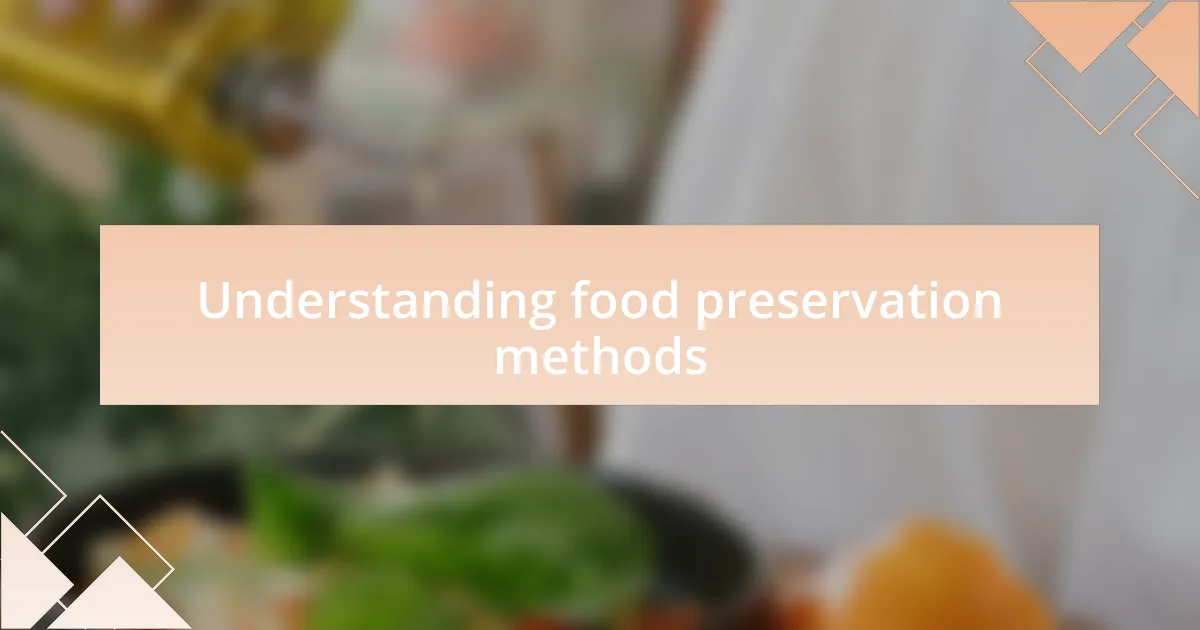
Understanding food preservation methods
Understanding food preservation methods is essential for anyone passionate about culinary education and sustainability. I remember the first time I made pickles; the anticipation of transforming fresh cucumbers into crisp, tangy delights was thrilling. Can you recall a moment when you tried preserving a favorite ingredient? It’s not just about extending shelf life; it’s about enhancing flavor and connecting with the seasons.
There are various methods, each with its own unique charm. My experiences with fermentation have truly opened my eyes to the magic of microbes. Watching cabbage turn into sauerkraut, bubbling with life, sparked a fascination in me. Isn’t it incredible how simple ingredients can undergo such transformations?
Then there’s drying, a method I’ve employed countless times. I vividly recall drying herbs from my garden; the vibrant aromas filled my kitchen as I hung them to dehydrate. This process not only preserves but intensifies the flavors, making a humble dish shine. Isn’t it amazing how these techniques allow us to capture the essence of our meals?
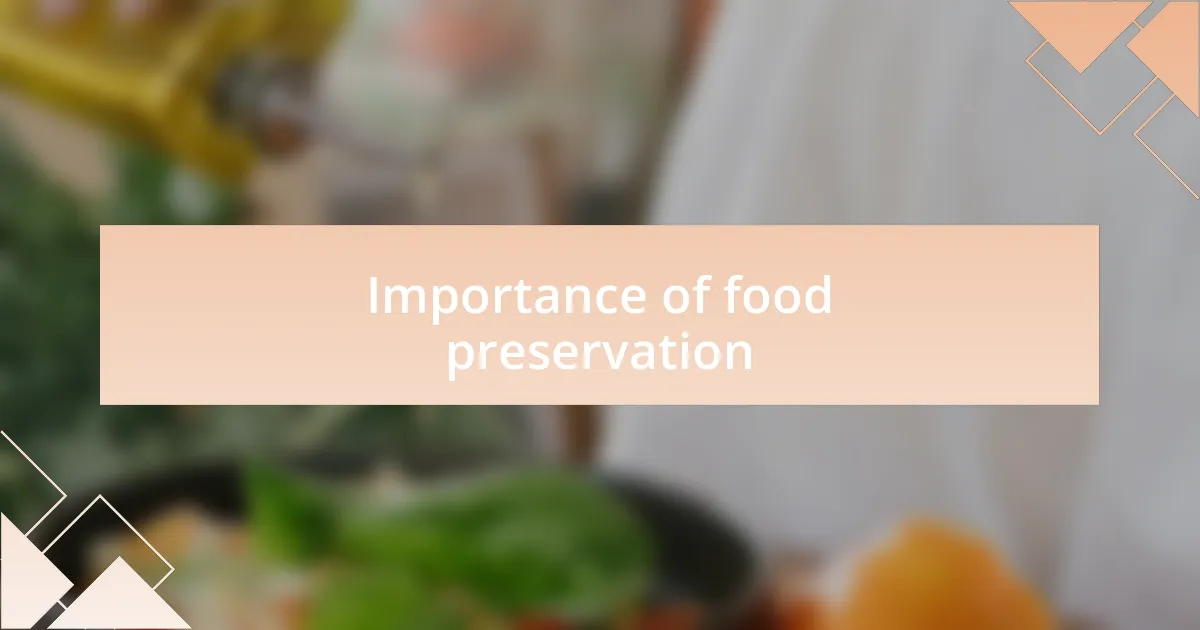
Importance of food preservation
Food preservation plays a crucial role in reducing waste and extending the lifespan of our ingredients. I can still recall the pride I felt when I realized how much I could save by canning tomatoes in late summer. It was a simple process, but the ability to enjoy the taste of summer all year long felt incredibly rewarding. Have you ever considered how much food is lost if not preserved properly?
Moreover, preserving food fosters a deeper connection with our culinary heritage. I remember diving into my grandmother’s recipe box, where she meticulously recorded her methods for drying fruits and making jams. Each recipe told a story, connecting me to generations before me. It made me think: how much do we lose when we skip these age-old practices in our kitchens?
Lastly, it’s important to recognize that food preservation can be a creative outlet. Trying out different techniques, like smoking or curing, takes experimentation and can lead to delightful surprises. I once stumbled upon a cured salmon recipe that transformed my breakfast routine; it turned a simple bagel into a gourmet experience. Isn’t it fascinating how preservation can not only prevent spoilage but also elevate our culinary adventures?
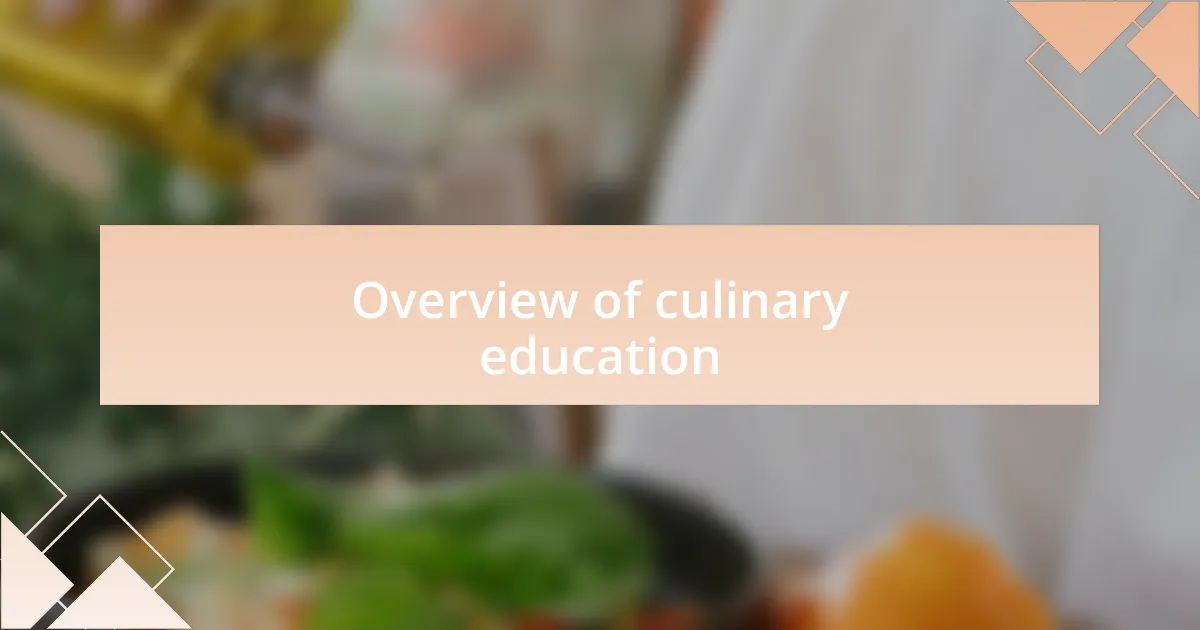
Overview of culinary education
Culinary education encompasses a broad spectrum of knowledge, from basic cooking techniques to advanced preservation methods. I vividly remember my first culinary class, where I learned the fundamentals of knife skills alongside the science of heat and flavor. This journey ignited a passion for not just cooking, but understanding the ‘why’ behind every technique.
At its core, culinary education is not just about following recipes; it’s about fostering creativity and innovation in the kitchen. I fondly recall a workshop focused on fermentation, where I transformed simple ingredients into tangy kimchi. That first taste was a revelation, reminding me how education can turn ordinary food into extraordinary flavors. Isn’t it amazing how each lesson can open doors to new culinary worlds?
Furthermore, culinary education encourages exploration and a hands-on approach, allowing aspiring chefs to gain practical experience. I often think of the joy I felt during my first food preservation project, where I meticulously crafted homemade pickles. The taste was a testament to the power of learning by doing. This interactive approach fosters a deep appreciation for ingredients and builds skills that last a lifetime. Wouldn’t you agree that real learning happens when we roll up our sleeves and dive in?
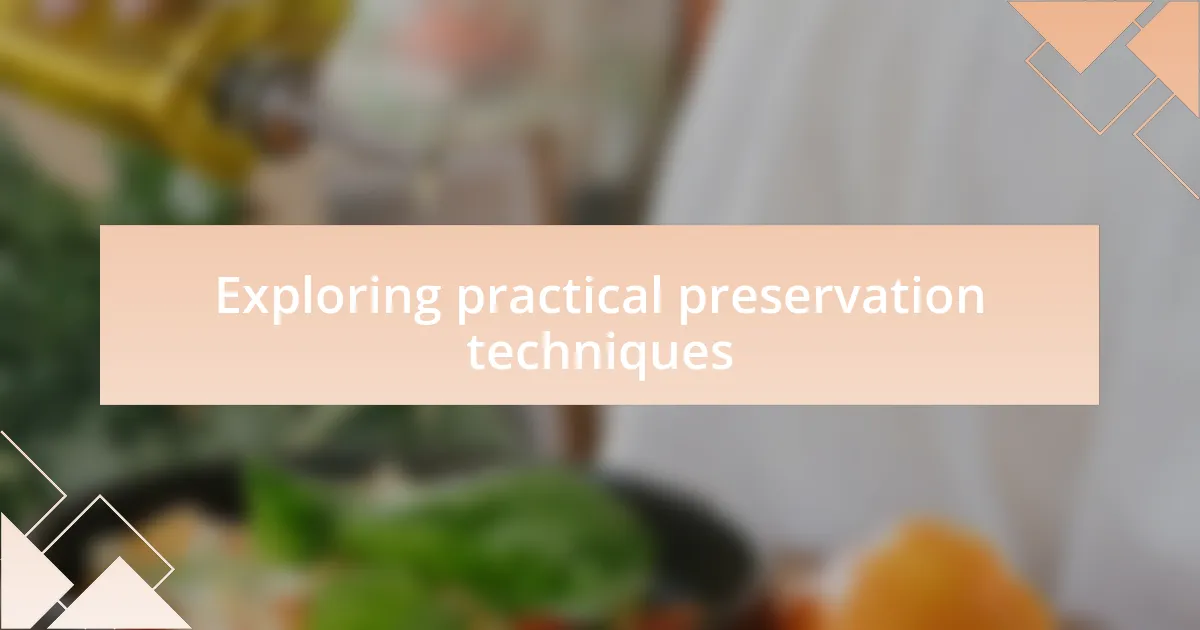
Exploring practical preservation techniques
I remember diving into the world of canning during one of my summer culinary programs. The aroma of boiling jars and the satisfying pop of lids sealing brought an unexpected thrill. It was like sealing in the essence of summer, allowing the bright flavors of tomatoes and peaches to shine even in winter. Have you ever preserved something and felt that rush of nostalgia wash over you?
Fermentation quickly became my favorite method to explore. I was astounded by how simple ingredients like cabbage and salt could transform into a vibrant, probiotic-rich dish. The layering of flavors over time taught me patience, something I often overlooked in my fast-paced kitchen adventures. Isn’t it fascinating how time can change the taste and health benefits of our food?
One day, I experimented with drying herbs from my garden. Watching them wilt and shrink under the heat was a lesson in concentration; that simple process turned my culinary creations into something truly special, enhancing flavors with just a sprinkle. Have you tried drying your own herbs? It’s remarkably satisfying to know that you can capture summer in a jar, ready for your next dish.
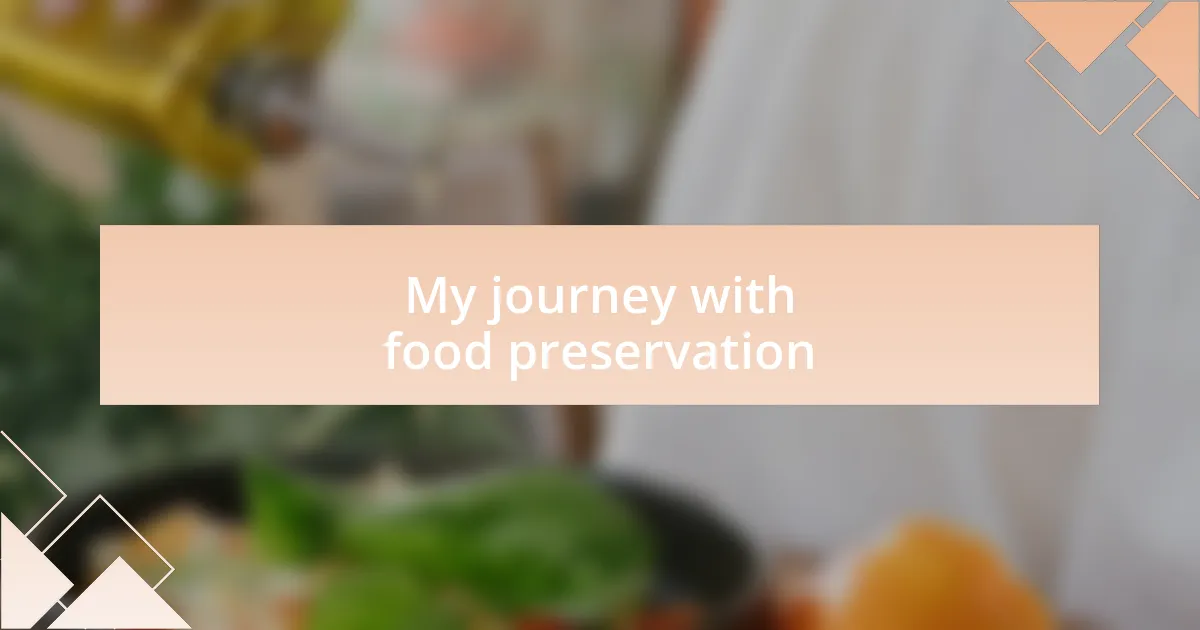
My journey with food preservation
I recall the first time I made jam—it was a lesson in both triumph and disaster. I had decided to use an assortment of berries from my local farmers’ market, and as I stirred the bubbling mixture, I felt a rush of excitement. However, my lack of experience led to an accidental overflow, resulting in a sticky kitchen and a humbling reminder of the importance of precision. Have you ever faced a mishap in the kitchen that made you appreciate the process even more?
The art of pickling also captivated me, especially when I wanted to preserve the crunch and zest of fresh vegetables. I experimented with different spices and brine ratios, and soon my refrigerator was brimming with colorful jars. Each time I opened one, it felt like a little treasure hunt—what flavor combination would I discover this time? It made me realize how preservation can be a delightful adventure in both taste and creativity.
In my quest for preservation, smoking certain meats also sparked my curiosity. I remember the first time I set up my smoker; the anticipation filled the air as the aromatic wood chips began to work their magic. Watching the transformation and savoring that deep, smoky flavor turned an ordinary meal into an extraordinary experience. Have you ever tried smoking your own food? The process not only enhances flavor but also creates memories that linger long after the meal is over.
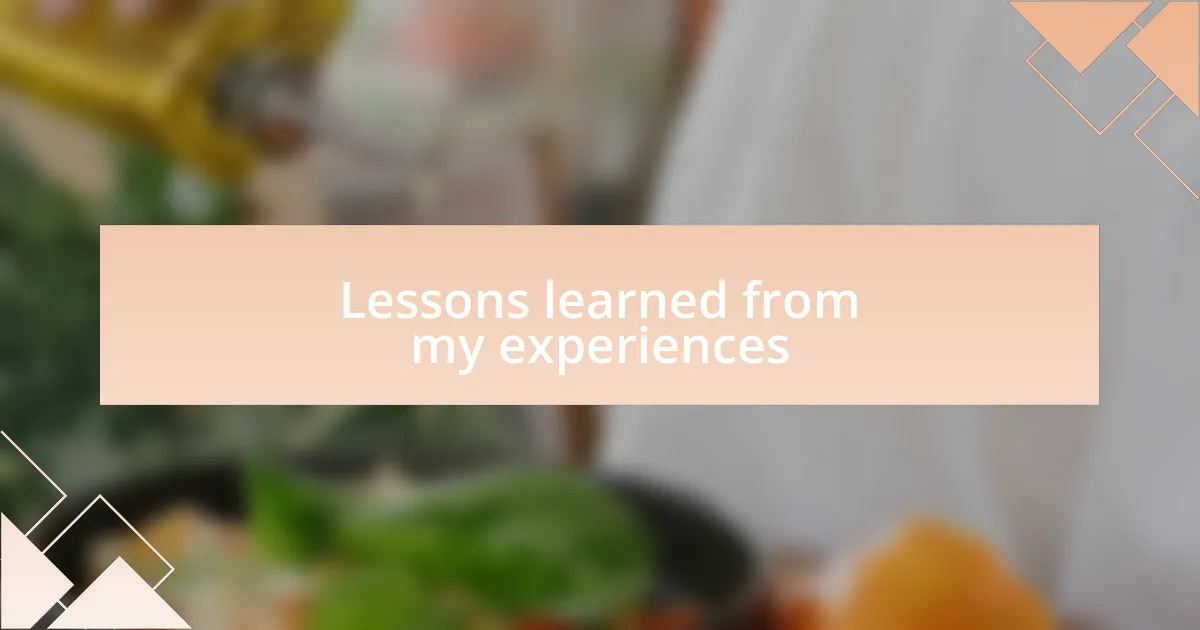
Lessons learned from my experiences
There was a moment during my journey with food preservation that truly cemented the importance of patience. While experimenting with fermentation, I remember eagerly checking my jars every few hours, longing for that perfect tang. It wasn’t until a full week had passed that I finally tasted the fruits of my labor, and I learned that sometimes, the best flavors take time to develop—just like good relationships.
One unexpected lesson came from canning. I had always thought it was simply about sealing in freshness, but the process forced me to confront my fears of failure. The first time I saw a jar seal properly, I felt an overwhelming sense of accomplishment. It was a reminder that every step, even the messy ones, is part of mastering a skill. Have you ever felt exhilarated over a seemingly small victory in the kitchen?
Embracing the art of preserving food has enriched my cooking in countless ways. As I explored various methods, I discovered new flavor profiles and textures that transformed everyday meals. Each preservation technique opened up a world of culinary creativity, reminding me that cooking is as much about experimentation as it is about tradition. Have you taken the leap to try something new, only to find it changed your perspective?